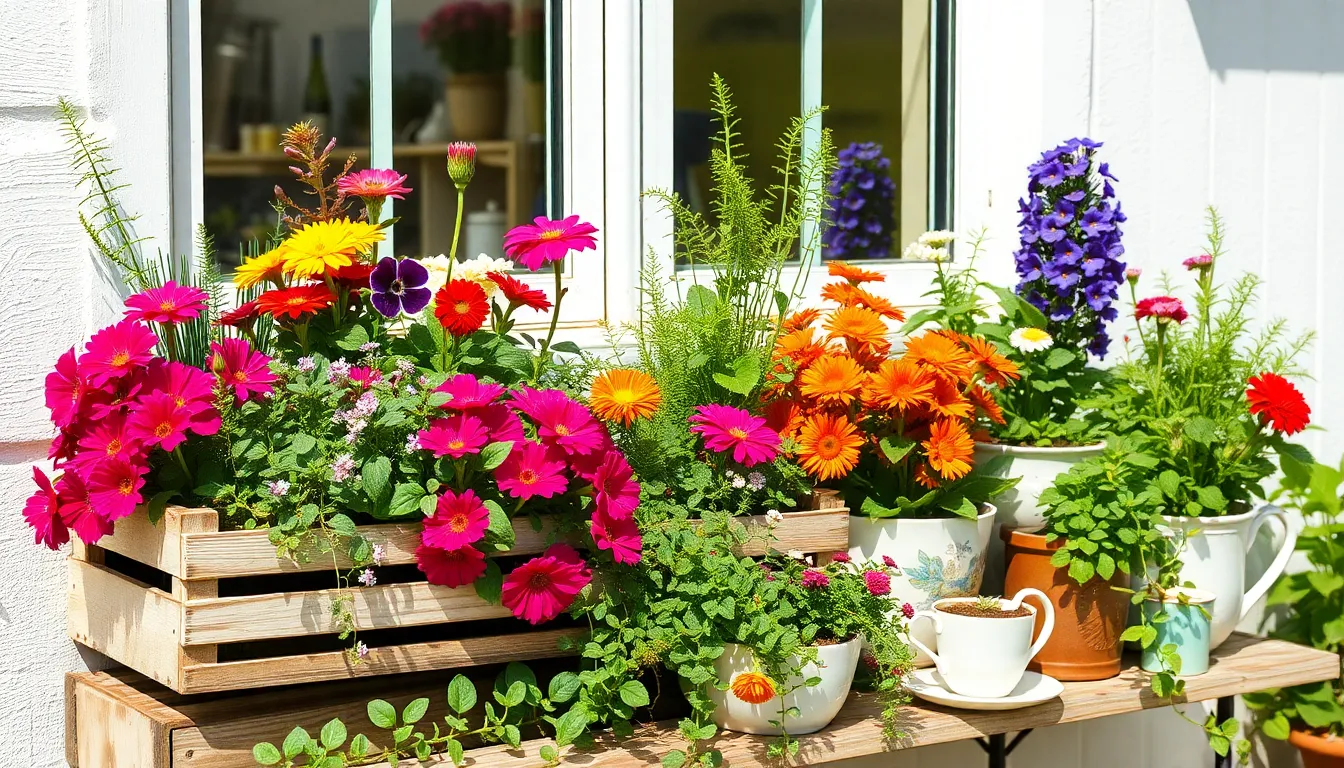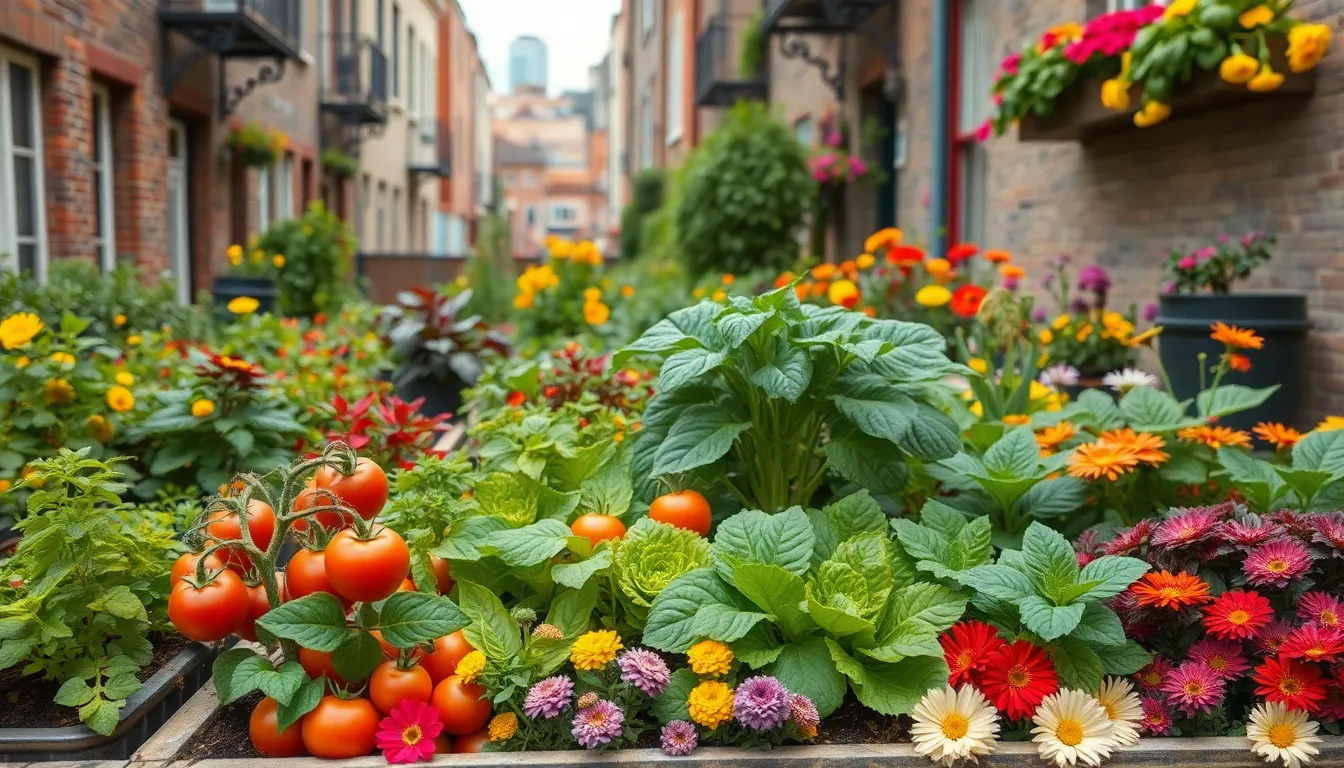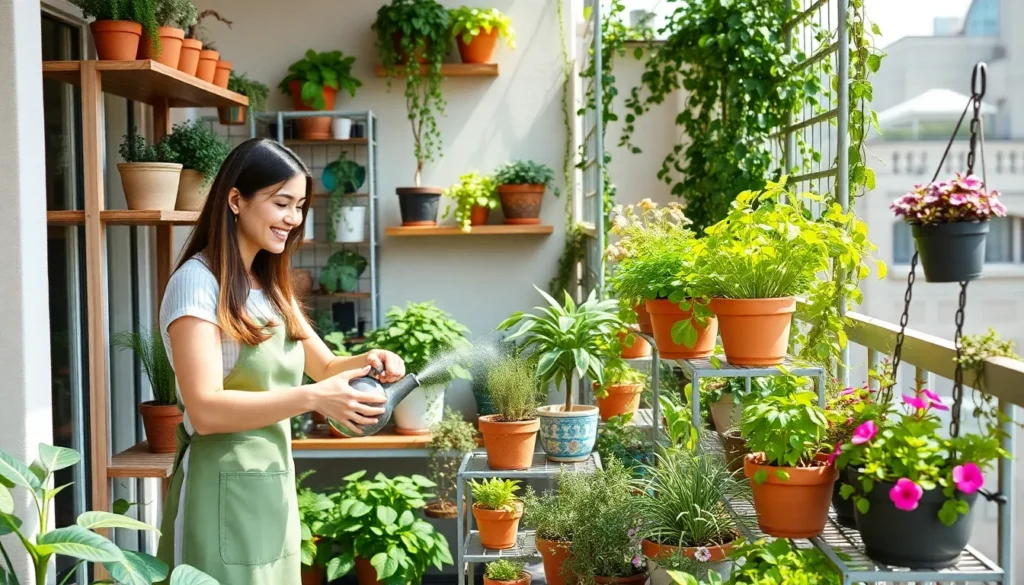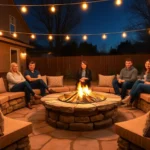We’ve all dreamed of having a lush garden bursting with vibrant flowers and fresh vegetables but felt limited by our compact outdoor spaces. Whether you’re working with a tiny balcony cramped backyard or even just a sunny windowsill the good news is that small doesn’t mean you can’t create something spectacular.
Small space gardening has exploded in popularity as more people discover clever ways to maximize every square inch. From vertical gardens that climb your walls to container systems that transform any corner into a green oasis we’ll show you how to think creatively about your space.
The secret isn’t about having more room – it’s about using what you have smarter. We’re about to share game-changing ideas that’ll help you create a thriving garden paradise no matter how tight your space constraints are.
Vertical Garden Solutions That Maximize Growing Space
We’ve discovered that thinking upward opens unlimited possibilities for small space gardening. These innovative vertical answers transform bare walls and empty air into thriving garden sanctuaries.
Living Walls and Trellises
Living walls create stunning focal points while maximizing every square inch of available space. We recommend installing pocket planters made from felt or fabric that can hold herbs like basil, cilantro, and parsley alongside compact vegetables such as lettuce and cherry tomatoes. These systems typically accommodate 20-30 plants in just 4 square feet of wall space.
Trellises provide essential support for climbing vegetables and flowering vines that naturally grow upward. We suggest positioning bamboo or metal trellis systems against sunny walls to support beans, peas, and cucumbers that can yield 3-4 times more produce than their ground level counterparts. Installing trellises with 6-inch spacing between supports creates optimal growing conditions for most climbing plants.
Modular wall systems offer flexibility to expand your garden as your confidence grows. These interlocking panels can be rearranged seasonally and typically cost $15-25 per square foot while supporting plants weighing up to 40 pounds per panel.
Hanging Planters and Suspended Gardens
Hanging baskets use overhead space that would otherwise remain empty and unproductive. We position these containers at varying heights to create visual interest while ensuring trailing plants like strawberries, cherry tomatoes, and cascading flowers receive adequate sunlight throughout the day.
Suspended herb gardens bring fresh flavors within arm’s reach of kitchen windows and outdoor cooking areas. These systems work particularly well for Mediterranean herbs such as oregano, thyme, and rosemary that prefer well-draining conditions and can thrive in containers as small as 6 inches in diameter.
Macrame plant hangers add bohemian charm while supporting lightweight plants in areas where traditional mounting isn’t possible. We recommend using these for air plants, small succulents, and trailing pothos that require minimal soil and water.
Stackable Tower Gardens
Hydroponic towers maximize growing capacity in minimal floor space while providing precise nutrient control. These systems can produce 30-50 plants in just 4 square feet and use 90% less water than traditional gardening methods while delivering harvests 25-30% faster than soil based growing.
Strawberry towers create impressive yields of fresh berries in containers that occupy less than 2 square feet of ground space. We stack these specialized planters to accommodate 15-20 strawberry plants that can produce 2-3 pounds of fruit per tower during peak season.
Rotating tower systems ensure all plants receive equal sunlight exposure while making maintenance tasks more manageable. These innovative designs typically hold 36-48 plants and can be rotated manually or automatically to optimize growing conditions throughout the day.
Container Gardening Ideas for Maximum Flexibility

Container gardens give us the freedom to experiment with different layouts and adapt our gardening spaces as our needs change. We can easily reposition planters throughout the season and create stunning displays that maximize every available inch.
Window Box Gardens
Continuous color schemes transform ordinary window boxes into eye-catching displays that enhance our home’s curb appeal year-round. We recommend selecting plants with complementary hues to create visual harmony that draws the eye naturally across the entire arrangement.
Diverse plantings maximize the potential of window box spaces by combining flowers, herbs, and succulents in creative arrangements. Mix trailing petunias with upright herbs like basil and rosemary, then add texture with small succulents that require minimal water and care.
Strategic plant placement creates depth and visual interest when we layer different heights and textures within the confined space. Position taller plants toward the back, medium-height varieties in the center, and cascading plants along the front edge for a professional industry look.
Raised Bed Containers
Space optimization becomes effortless with raised bed containers that create defined growing areas while improving soil quality and accessibility. We can position these portable gardens in optimal sunlight locations and move them seasonally to take advantage of changing light patterns.
Layered planting techniques maximize growing capacity within raised bed containers by utilizing vertical space efficiently. Plant tall crops like tomatoes or peppers in the center, surround them with medium-height plants like lettuce, and edge the container with trailing herbs or compact vegetables.
Improved drainage and soil control make raised bed containers ideal for small space gardening success. We can customize soil mixtures for exact plant needs and ensure proper drainage that prevents root rot common in traditional ground planting.
Repurposed Container Options
Creative reuse transforms everyday items into unique planters that add character while reducing waste in our small space gardens. Old wooden crates, vintage boots, and discarded pallets become conversation pieces that showcase our gardening creativity and environmental consciousness.
Thematic garden concepts come alive through repurposed containers that fit exact growing goals and aesthetic preferences. Create a dedicated herb garden using old kitchen colanders for drainage, or design a succulent display in vintage teacups and mason jars for a charming cottage garden feel.
Cost-effective answers emerge from repurposing household items that would otherwise end up in landfills. Drill drainage holes in plastic storage containers, transform old tires into colorful planters, or convert unused furniture drawers into rustic garden boxes that perfectly fit narrow spaces.
Space-Saving Herb Gardens for Culinary Enthusiasts

Fresh herbs elevate every dish from ordinary to extraordinary, and culinary enthusiasts can cultivate their own harvest regardless of limited outdoor space. These innovative herb garden answers maximize growing potential while keeping fresh flavors within arm’s reach of your kitchen.
Kitchen Windowsill Herb Gardens
Transform your kitchen windowsill into a thriving herb sanctuary that provides fresh ingredients for every meal. We position small pots of basil, rosemary, thyme, and oregano directly on windowsills that receive abundant natural sunlight throughout the day.
Select containers between 4-6 inches in diameter to accommodate herb root systems without overwhelming your windowsill space. Drainage becomes critical for windowsill success, so we drill holes in decorative containers or choose pots with built-in drainage systems.
Group herbs according to their watering needs to simplify maintenance routines. Mediterranean herbs like rosemary and thyme prefer drier conditions, while basil and cilantro thrive with consistent moisture levels.
Compact Herb Spirals
Design vertical herb spirals that maximize growing space by creating multiple planting levels within a minimal footprint. This spiral configuration provides distinct microclimates for different herb varieties while adding visual appeal to small garden areas.
Build spirals using stones, bricks, or recycled materials to create raised planting zones that improve drainage and soil quality. We start with a base diameter of 4-6 feet and spiral upward to create various planting levels for different herbs.
Plant moisture-loving herbs at the bottom where water naturally collects, and position drought-tolerant varieties like lavender and sage at the spiral’s peak. This natural water distribution system reduces maintenance while optimizing growing conditions for each herb type.
Portable Rolling Herb Carts
Invest in wheeled herb carts that adapt to changing sunlight patterns throughout your outdoor space or patio area. These mobile gardens feature multiple tiers that accommodate various pot sizes while providing easy access for harvesting and maintenance.
Position carts strategically to capture optimal sunlight during different seasons and times of day. We move these portable gardens to sunny morning spots and relocate them to afternoon shade when temperatures soar during summer months.
Choose carts with built-in water drainage systems to prevent root rot and maintain healthy growing conditions. Storage shelves underneath provide convenient space for gardening tools, watering cans, and extra pots for seasonal plantings.
Balcony Garden Ideas That Transform Outdoor Spaces

Balconies offer unique opportunities to create stunning garden retreats that maximize every square inch of available space. We’ll explore proven strategies that turn even the smallest outdoor areas into thriving green sanctuaries.
Privacy Screens with Climbing Plants
Creating natural barriers becomes effortless when we incorporate climbing plants like ivy or clematis into trellises. These living privacy screens serve dual purposes by blocking unwanted views while adding vertical growing space to our balcony gardens. Wall mounted trellises support vigorous climbers that can reach heights of 6-8 feet, effectively screening neighboring balconies or busy streets.
Dense foliage develops quickly with fast growing varieties like morning glories, which can cover a 4×6 foot trellis in just one growing season. We recommend selecting evergreen climbers such as English ivy for year round coverage, while deciduous options like grape vines provide seasonal interest and edible harvests. Strategic placement of these green screens creates intimate outdoor rooms that feel secluded even though urban surroundings.
Multi-Level Balcony Shelving
Optimizing vertical space through multi-level shelving systems displays plants at different heights while adding remarkable visual interest to our balcony gardens. These tiered arrangements create depth and dimension that make small spaces appear larger and more ever-changing. Sturdy metal or wooden shelving units can accommodate 15-20 containers across three levels, tripling our growing capacity without expanding floor space.
Graduated plant heights work best when we place trailing species on upper shelves and upright varieties below. This cascading effect draws the eye upward and creates natural flow between different planting zones. Adjustable shelving systems adapt to changing plant sizes throughout the growing season, ensuring optimal light exposure for each container as our garden matures.
Weather-Resistant Plant Selections
Selecting plants that withstand wind and intense sun exposure ensures our balcony gardens thrive even though challenging conditions. Succulents like sedums and echeveria tolerate harsh weather while requiring minimal maintenance, making them perfect choices for busy gardeners. Heat tolerant flowers such as marigolds, zinnias, and portulaca bloom continuously through summer’s hottest months without wilting.
Wind resistant varieties prevent damage during storms and strong gusts common in elevated locations. We’ve found that plants with flexible stems like ornamental grasses and sturdy herbs such as rosemary and lavender bend rather than break in challenging weather. Self watering containers or aquapots reduce our watering frequency while ensuring consistent moisture levels during extreme temperatures, helping sensitive plants survive harsh conditions with minimal intervention.
Indoor Growing Solutions for Year-Round Gardening

Moving from outdoor growing into interior spaces opens unlimited possibilities for continuous harvests. We can maintain productive gardens throughout every season with the right indoor growing answers.
Hydroponic Systems for Small Spaces
Hydroponic systems revolutionize small space gardening by using 90% less water than traditional soil methods while producing four times more crops. Companies like Gardyn have developed vertical hydroponic towers that accommodate up to 30 plants in just 2 square feet of floor space. AeroGarden offers compact countertop models perfect for apartments and condos, making fresh vegetable production accessible year round.
Efficiency becomes the primary advantage when space is limited. We can grow lettuce, herbs, tomatoes, and peppers simultaneously in these soil free systems. Nutrient delivery happens automatically through water circulation, eliminating the guesswork of traditional watering schedules.
Variety expands dramatically with hydroponic growing methods. Gardyn systems support everything from leafy greens and culinary herbs to strawberries and flowering plants. Root vegetables like radishes and carrots also thrive in these controlled environments.
LED Grow Light Setups
LED grow lights provide essential illumination for indoor plants, especially in spaces lacking adequate natural sunlight. Modern LED systems offer adjustable intensity and programmable timers that simulate natural day and night cycles. We can position these lights at optimal distances to prevent burning while ensuring proper photosynthesis.
Energy efficiency makes LED technology the preferred choice for continuous indoor growing. These lights consume significantly less electricity than traditional fluorescent or incandescent grow lights while producing less heat. Full spectrum LEDs support all growth stages from seedling development through flowering and fruiting.
Adjustability allows customization for different plant types and growth phases. We can modify light intensity, duration, and color spectrum based on exact plant requirements. Blue light promotes leafy growth while red light encourages flowering and fruit production.
Microgreens and Sprout Gardens
Microgreens require minimal space while delivering maximum nutritional value, making them perfect for windowsill cultivation. These nutrient dense plants can be harvested in just 7 to 10 days, providing fresh produce faster than any other growing method. Small trays measuring 10 by 20 inches can yield multiple harvests per month.
Space saving becomes effortless with microgreen production systems. We can stack multiple growing trays vertically to multiply our harvest capacity without expanding our footprint. Simple plastic containers with drainage holes work perfectly for most microgreen varieties including arugula, radish, and pea shoots.
Quick turnaround allows continuous harvests throughout the year. Seeds germinate within 2 to 3 days, and most microgreens reach harvestable size within one week. We can stagger plantings every few days to ensure constant fresh produce availability for salads, sandwiches, and garnishes.
Creative DIY Projects Using Recycled Materials

Transforming everyday discarded items into functional garden elements saves money while reducing environmental waste. We’ll explore three innovative approaches that turn common recyclables into thriving garden spaces.
Pallet Garden Installations
Pallet gardens offer incredible versatility for vertical growing in tight spaces. We disassemble wooden pallets and repurpose the boards to create square planter boxes that stack vertically against walls or fences. These installations accommodate multiple plant varieties while using minimal floor space.
Preparation involves sanding rough edges and applying food-safe wood sealant to prevent rot. We drill drainage holes in each compartment and line them with industry fabric to retain soil while allowing water flow. The modular design lets us rearrange planters seasonally or relocate them as needed.
Plant selection works best with shallow-rooted varieties like lettuce, herbs, strawberries, and succulents. We fill each compartment with lightweight potting mix rather than heavy garden soil to reduce structural stress. This approach yields impressive harvests from a 4×6 foot wall space.
Tire Planter Arrangements
Tire planters transform discarded rubber into durable container gardens that withstand harsh weather conditions. We select tires of varying sizes to create ever-changing visual arrangements while maximizing growing space through strategic stacking.
Installation requires drilling multiple drainage holes in the tire’s sidewall and bottom. We fill larger tires with gravel for drainage, then add quality potting soil mixed with compost. The black rubber naturally absorbs heat, extending growing seasons in cooler climates.
Creative arrangements include painting tires with outdoor paint in vibrant colors or wrapping them with rope for a natural aesthetic. We stack different sized tires to create tower gardens perfect for cascading plants like trailing tomatoes, petunias, or sweet potato vines.
Shoe Organizer Vertical Gardens
Hanging shoe organizers become instant vertical gardens when mounted on walls, fences, or balcony railings. We choose organizers with clear pockets to monitor plant health and root development while maintaining easy access for maintenance.
Setup involves securing the organizer to a sturdy support structure and filling each pocket with lightweight potting mix. We poke drainage holes in pocket bottoms to prevent water accumulation and root rot. This system accommodates 20-24 individual plants in just 2 square feet of wall space.
Optimal plants include herbs like basil, oregano, and thyme alongside compact vegetables such as lettuce, spinach, and cherry tomatoes. We group plants with similar watering needs in adjacent pockets for efficient maintenance. This method produces fresh herbs and greens within arm’s reach of kitchen windows.
Small Space Vegetable Gardens That Produce Big Yields

Growing vegetables in limited space doesn’t mean sacrificing abundant harvests. Strategic planning and smart techniques can transform even the smallest garden areas into productive food sources.
Square Foot Gardening Method
Square foot gardening revolutionizes small space productivity by dividing garden beds into 1×1 foot sections. Each square accommodates different vegetables based on their mature size, allowing us to plant 16 carrots, 4 lettuce heads, or 1 tomato plant per section. This systematic approach eliminates wasted space and maximizes resource efficiency.
Dense planting within each square creates natural weed suppression while maintaining proper spacing for healthy growth. We can arrange squares to create companion planting combinations, such as placing basil next to tomatoes or carrots alongside onions. The method requires less water and fertilizer than traditional row gardening while producing higher yields per square foot.
Succession Planting Techniques
Succession planting ensures continuous harvests throughout the growing season by staggering plantings every 2-3 weeks. Salad greens exemplify this technique perfectly, as we can sow a second batch of seeds two weeks after the first planting to maintain steady fresh produce availability. Multiple containers help this rotation system, allowing us to plant new seeds while harvesting mature crops.
Staggered planting prevents overwhelming harvests and reduces food waste by spreading production over time. Fast growing crops like radishes and lettuce work exceptionally well with succession planting, completing their growth cycle in 20-30 days. We can extend harvest seasons by selecting varieties with different maturity dates, ensuring fresh vegetables from spring through fall.
Compact Vegetable Varieties
Dwarf vegetable varieties deliver full size flavors in space saving packages specifically bred for small gardens. Compact tomato varieties like ‘Tiny Tim’ and ‘Tumbling Tom’ produce abundant fruit while occupying minimal vertical space. Cucumber varieties such as ‘Bush Champion’ grow in containers without requiring extensive trellising systems.
Leafy greens offer the fastest returns on garden space investment, with lettuce and spinach ready for harvest in just 20 days after planting. These quick turnaround crops allow multiple plantings per season in the same container or garden section. Root vegetables like ‘Paris Market’ carrots and ‘Hakurei’ turnips mature in compact sizes perfect for container growing while maintaining excellent flavor profiles.
Bush varieties of traditionally vining plants maximize productivity in confined spaces. Bush beans produce concentrated harvests without requiring support structures, while determinate pepper varieties stay compact while producing abundant fruit throughout the season.
Multi-Functional Garden Furniture and Storage Ideas

Maximizing every square inch becomes essential when working with limited outdoor spaces. Smart furniture choices that serve multiple purposes help us maintain both functionality and beauty without creating clutter.
Garden Benches with Built-In Planters
Garden benches with built-in planters combine comfortable seating with growing space in one compact design. We can use these innovative pieces to cultivate small flowers, herbs, or decorative plants while providing a relaxation spot for ourselves and guests. These dual-purpose benches work exceptionally well on balconies, patios, or tight backyards where space comes at a premium.
Built-in planters transform ordinary seating into living garden features that enhance our outdoor experience. The integrated design allows us to enjoy our plants up close while sitting, creating an intimate connection with our garden. We’ll find these benches particularly valuable for growing aromatic herbs like basil, rosemary, and thyme that we can easily reach for cooking.
Storage Ottoman Planters
Storage ottoman planters offer triple functionality as seating, planting containers, and hidden storage answers. These versatile pieces feature hinged lids that conceal garden tools, gloves, or small cushions while supporting flowers or herbs on top. We can keep our garden areas tidy and organized by storing essential items out of sight.
Customization options make these planters perfect for matching our existing garden decor. Weather-resistant fabrics and coordinating colors help us create a cohesive look throughout our small outdoor space. The dual functionality means we’re getting maximum value from each piece of furniture we choose.
Fold-Down Wall-Mounted Garden Tables
Fold-down wall-mounted garden tables maximize functionality in extremely limited spaces through their space-saving design. We can install these tables against fences or walls and open them for potting plants, outdoor dining, or displaying decorative elements. When not in use, they fold completely flat against the wall to free up valuable floor space.
Murphy table mechanisms make these installations practical for apartments or homes with minimal outdoor areas. The folding feature ensures we maintain open pathways and avoid overcrowding our plants, which supports proper air circulation for healthy growth. We’ll appreciate how these tables appear when needed and disappear when we want maximum space for movement and plant care.
Conclusion
Small space gardening proves that we don’t need acres of land to create our own green paradise. With vertical answers container systems and creative DIY projects we can transform even the tiniest spaces into productive gardens that provide fresh herbs vegetables and beautiful flowers year-round.
The key lies in thinking creatively about every available inch and choosing multi-functional answers that serve multiple purposes. Whether we’re working with a windowsill balcony or small patio these techniques help us maximize our growing potential while staying within budget.
We’ve shown that limited space shouldn’t limit our gardening dreams. With the right approach and a bit of creativity we can cultivate thriving gardens that enhance our homes and provide fresh produce regardless of our space constraints.
Frequently Asked Questions
What is small space gardening and who can benefit from it?
Small space gardening is the practice of creating beautiful gardens in limited outdoor areas like tiny balconies, windowsills, or small yards. Anyone with limited space can benefit, including apartment dwellers, urban residents, and homeowners with compact outdoor areas. The key is maximizing existing space through smart techniques rather than needing more room.
How do vertical gardens work and how much space do they save?
Vertical gardens utilize upward space through living walls, trellises, and hanging planters. They can accommodate 20-30 plants in just 4 square feet by transforming bare walls into thriving garden sanctuaries. This technique maximizes growing capacity while using minimal floor space, making it perfect for small areas.
What are the best container gardening ideas for small spaces?
Container gardening offers maximum flexibility with window boxes, raised bed containers, and creative repurposed planters. You can experiment with layouts, adapt seasonally, and use everyday items as unique planters. Layered planting techniques in containers help maximize growing capacity while maintaining visual appeal and sustainability.
How can I create a space-saving herb garden?
Transform kitchen windowsills into herb sanctuaries with small pots of basil, rosemary, thyme, and oregano. Use compact herb spirals for multiple planting levels or portable rolling herb carts that adapt to changing sunlight. Group herbs by watering needs and ensure proper drainage for optimal growth.
What plants work best for balcony gardens?
Weather-resistant plants like succulents and heat-tolerant flowers thrive in challenging balcony conditions. Use climbing plants on trellises for natural privacy screens and vertical growing space. Multi-level shelving systems optimize vertical space, while self-watering containers help maintain consistent moisture levels for plant health.
Can I garden indoors year-round in small spaces?
Yes, hydroponic systems use 90% less water while producing four times more crops than traditional methods. Vertical hydroponic towers and compact countertop models make fresh vegetable production accessible indoors. LED grow lights provide adjustable illumination to support plant growth stages while being energy efficient.
What are microgreens and how do I grow them in small spaces?
Microgreens are young vegetable greens that require minimal space and offer quick harvests, making them ideal for windowsill cultivation. You can stack growing trays to maximize yield and stagger plantings for continuous fresh produce availability. They’re perfect for beginners and provide fresh nutrients year-round.
How can I use recycled materials for small space gardening?
Create DIY projects using pallet garden installations, tire planter arrangements, and shoe organizer vertical gardens. Disassemble wooden pallets for vertical planter boxes, repurpose tires into durable containers, and transform hanging organizers into functional planting spaces. These methods emphasize sustainability and cost-effectiveness.
What vegetables grow best in small spaces?
Use the square foot gardening method, dividing beds into 1×1 foot sections for efficient planting. Compact varieties like dwarf tomatoes, cucumbers, and bush beans maximize flavor and productivity. Succession planting techniques ensure continuous harvests throughout the growing season in limited space.
How can I make my small garden space multi-functional?
Incorporate garden benches with built-in planters, storage ottoman planters that serve as seating, and fold-down wall-mounted garden tables. These innovative furniture solutions combine growing space with functionality, providing versatile surfaces for potting or dining while ensuring every inch of outdoor space is utilized effectively.







